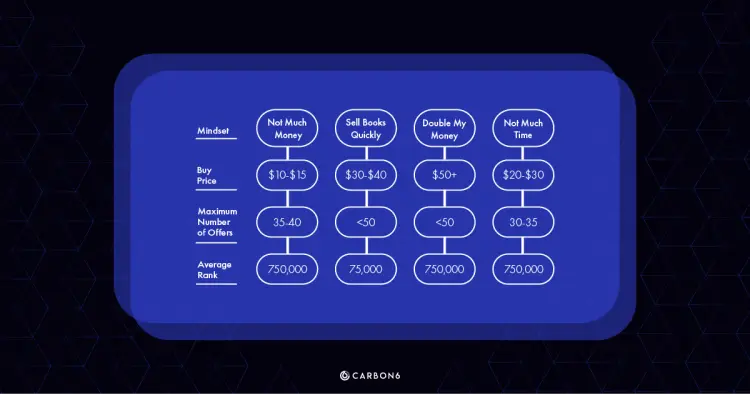If you’re new to the process, Amazon arbitrage for beginners is pretty simple: the motto is buy low, sell high.
It’s the process of strategically using the different price points of multiple markets to earn a high profit. And while it’s an oft-dismissed commerce strategy, it can also be a powerful tool for those who learn how to use it well.
What do people want out of an arbitrage strategy? Some want a side hustle to gain a little extra spending money. Others want a second job. Still others want arbitrage to be their core job, which they’ll manage while sitting on a beach. Your goals — and your mindset — will impact your approach to this business.
Here’s how arbitrage works on Amazon, why books can be a lucrative arbitrage product, and how your personality can be a boon to your business.
Amazon Arbitrage for Beginners: In a Nutshell
When a customer searches for a product on Amazon, they immediately see the “buy box” on the right side of their screen, offering options to “add to cart” or “buy now.” But if they scroll down a little further, they’ll also find an option to see “other sellers on Amazon.”
And that’s where the magic happens.
Sometimes the big shiny name at the top of a product list doesn’t offer the best, or even the cheapest, deal. Amazon’s algorithm considers lots of factors when deciding which seller goes in the buy box, so sometimes cheaper products sit further down the list.
A winning strategy? Buying the cheaper item and reselling them for a profit.
You might be thinking, if people can get a cheaper version of a product, why don’t they just buy it themselves? Fair question.
But it’s all about convenience. People generally want to press a button and get their product tomorrow. They don’t want to search through multiple sellers and potentially wait two weeks for delivery.
The other big factor is trust. People trust Amazon for quality control, in no small part because the Amazon ranking algorithm privileges trustworthy sellers. When they buy fulfillment by Amazon (FBA) products, they believe that the label will give them a higher-quality product and a better purchasing experience.
So here’s the Amazon arbitrage playbook:
- Buy cheap books — those that tend to sit toward the bottom of the product list — that people ignore.
- Send them to your FBA warehouse.
- Mark up the price, and resell them with convenient FBA shipping.
But Why Books?
Since the principles of arbitrage work with any product, what makes bookselling a better opportunity than any other?
When it comes to profit margins, books offer huge potential. If you’ve ever sold a textbook to a college bookstore for a small amount, only for them to resell it at a double- or triple-digit price, you’ve seen firsthand how lucrative book arbitrage can be.
Printed books also remain a popular format, despite the technological turn toward other forms of media. And people don’t mind buying them secondhand to save some money, so they circulate well.
Books are also great because they’re compact. Being able to fit a ton of books in a small warehouse means saving on storage fees.
Mindsets of New Book Arbitrage Sellers

Because of the low cost of used books and the potential for a high reselling point, books are the perfect arbitrage product. But to make the most of the book business, it’s important to understand the mindset you’re coming in with. Here are four to consider.
1. “I don’t want to invest a lot of money”
Whether you don’t have much money to spare, or you’re afraid of being burned by scams, you can still test the arbitrage waters with only $100 to $500.
Set your sights on books with a low price point — those in the $10 to $15 range, including shipping and handling costs. Even with only a few hundred dollars to start with, you can stock a lot of books.
From there, you can make a good amount of profit. After all, selling a $10 book for $20 is doubling your money.
Another important factor is the number of total listings of the book. If there are hundreds of other sellers listing a particular book, your resell offer might get lost in the mix. For your strategy, look for a maximum of 35 to 40 offers.
After you’ve sold your first set of books, consider reinvesting that money into your new business. Then, simply watch the momentum build.
2. “I want to sell books quickly”
Sellers with this mindset typically want to see cash in 30 days or less. This turnaround time is possible, but it requires a particular strategy.
If quick cash is your main goal, focus on popular books. Set your purchase price for $30 to $40 and look for books with an average ranking of 75,000.
A word of caution for these sellers: Some current, popular books have reselling restrictions from their publishers, so you’re likely to run into more of these restricted books in your searches. Don’t let that stop you from reaching your goals, though. Plenty of popular books are available for a quick flip.
3. “I want to double my money”
Most sellers would love a 100% return on their investment. If you want those kinds of results, you’ll likely need to invest more per book.
Look to buy books that are $50 or more that have an average product rank of 750,000 — which are typically college textbooks.
Since you’re looking at much more expensive prices, you’ll naturally exclude a lot of books on Amazon. That’s ok.
The tradeoff is that you’re making significantly more money per book, which requires less effort than buying and selling more books for smaller profit margins.
4. “I don’t have much time”
A seller’s most precious resource? Time.
If you already have a full place and can only invest an hour or so a day into your book arbitrage, the best strategy is to find the sweet spot between popular and affordable books without excessive competition.
Set your purchase price in the range of $20 to $30, and look for books with an average rank of 750,000. You should also select books with no more than 30-35 offers to keep competition low. If Amazon is one of your competing sellers, make sure their price is set at more than $50. That will ensure that you can offer a more enticing, but still profitable, price point.

Hit the Ground Running
For a seller with any one of these mindsets, the hardest part is always getting started. There’s always some small details that take some time to get the hang of.
But you shouldn’t let that stop you.
If you’re spending time finding the perfect deal or manually setting up your business, don’t give up. Successful arbitrage sellers use powerful software like Zen Arbitrage to do the searching and price comparisons for them.
Zen Arbitrage will save you countless hours of staring at a screen trying to find the perfect books. It includes video lessons on mastering the world of online book arbitrage and a vast community of experts ready to share their wisdom and advice.
Whether you’re looking for a little extra cash or a new career, an arbitrage strategy can open the door to where you want to be.





